英语时态总结表格.ppt
英语时态8种基本时态讲解.ppt课件

8.过去完成时 表示动作发生在过去某一时间之前已经完成的动作或状态, 强调“过去的过去”, 常与 by the time, by the end of…,before , by 等引导时间的状语连用。
基本结构 主语+ had + 动词过去分词 + 其他成分 When I got to the cinema yesterday the film had begun already. He had learned English before he came here.
现在完成时与一般过去时的区别: 1)现在完成时侧重于对现在的影响;而一般过去时侧重于某一动作发生在过去某个时间或某段时间。即现在完成时侧重于现在的结果,而一般过去时侧重于动作发生的时间。例如:
I have seen the film. 我看过这部电影。(现在我仍记得电影的内容) I saw the film three days ago. 三天前我看了这部电影。(强调是三天前,而不是别的什么时候看的电影)
be going to含有“打算,准备”的意思,而will则没有这个意思, She is going to lend us her book. He will be here in half an hour.
be about to+V.原形(意为马上做某事,在时间上指最近的将来) I am about to leave school. 不能与表示时间的副词连用。 They are about to set out.(√) They are about to set,变y为i加-ed. study----studied carry----carried cry----cried try----tried d)以元音字母+y结尾的单词直接加-ed. play----played stay----stayed
八大时态讲解(共26张PPT)

0 一般过去将来时:
He was sixty-eight. In two years he would be seventy.
I knew you would agree.
0 现在英进行语时的: 动词时态(进行) What are you doing?
算;
如:I am going to listen to music. (我打算听音乐) will /shall 表示未事先思考或为计划过的意图
如:It will be Christmas soon .(很快就圣诞节了)
4. 现在进行时态( The Present Continuous Tense )
5、我们离开广州六年了。
We have left Guangzhou for 6 years . ×
We have been away from Guangzhou for 6
years .
3.常见句型
1) 主句(现在完成时)+since 从句(一般过去时).
2) It is +一段时间+ since 从句(一般过去时).
has gone to
He said had seen this morning, …ago, etc
that he _________the film many 如果明天不下雨,我们将去野营。
He has borrowed the pen for three days .
times. 现在进行时态( The Present Continuous Tense )
was /were going to +动词原形
初中英语八种时态归纳PPT
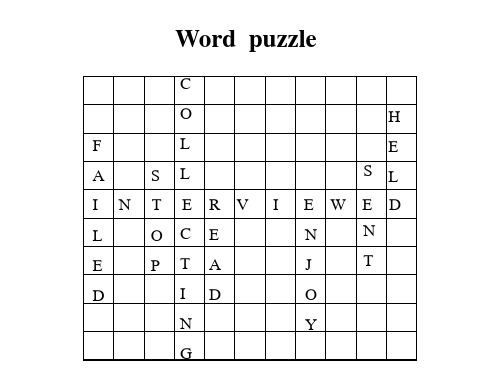
Part B 语态
Active Voice
Passive Voice
主动语态
1. Many people speak English.
At the party.
--- I _l_ik_e___ your jacket, Tim. How long _h_a_v_e_y_o_u__h_a_d__ it?
Oh…er… I __b_o_u_g_h_t__it last week. W__o_u_l_d_y_o_u__li_k_e_ to dance, Becky? ---Phew. It’s __h_o_t__ here. --- Put your jacket on the chair. You ____n_e_e_d_n’wt orry. It’ll be ok. ---That’s _b_e_tt_e_r __.
8. Mr. Green and his wife had lived (live) in London for a few years before they came (come) to work in China in 2001.
9. He said he w__o_u_ld__n_o_t_s_p_e_a(k not,speak) at the meeting the next day.
4. Hurry! Your classmates _a_r_e_w__a_it_i_n_g(wait) for you in the classroom..
1. This is the third time you _h_a_v_e__b_e_e_n__(be) here.
英语的时态和语态 ppt课件
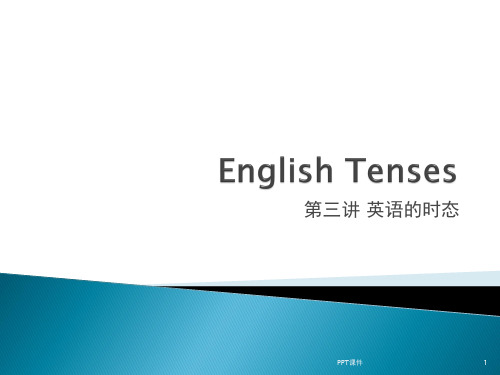
He worked for us
PPT课件
8
am/are/is+going to+do 或
will/shall+do
am/is/are/about to + do
am/is/are to + do;
一般将来时的表达方法
be going to +动词原形
be +不定式,be to+动词原形,be about to +动词原形
by the end of + 过去的时间点。如:
We had learnt over two thousand English words by the end of last t erm.
before + 过去的时间点。如:
They had planted six hundred trees before last Wednesday.
例:He is working.
PPT课件
12
肯定句:主语+was/were+doing+其它
否定句:主语+was/were+not+doing+其它
一般疑问句及答语:Was/Were+主语+doing+其
它 ;答语:Yes,I主语+was/were./No,I主语+wasn't/w
eren't.
He usually goes to work at 7 o’clock every morning. 他每天7点上班。 2、现在进行时 表说话时或目前一段时间内正在进行的活动:或表感情色彩,加强语气。与频
12时态语态总结表格

时态
主动语态结构
被动语态结构
一般现在时
主语 + do/does
主语 + am/is/are + done
一般过去时
主语 + did
主语 + was/were + done
一般将来时
主语 + will/shall + do
主语 + will/shall be + done
过去将来时
现在完成进行时
主语 + have/has been + doing 主语 + have/has been being + done
过去完成进行时
主语 + had been + doing
主语 + had been being + done
主语 + will/shall be being + done
现在完成时
主语 + have/has + done
主语 + have/has been + done
过去完成时
主语 + had + done
主语 + had been + done
将来完成时
Hale Waihona Puke 主语 + will/shall have + done 主语 + will/shall have been + done
主语 + would + do
主语 + would be + done
现在进行时
主语 + am/is/are + doing
英语语法16种时态介绍ppt课件
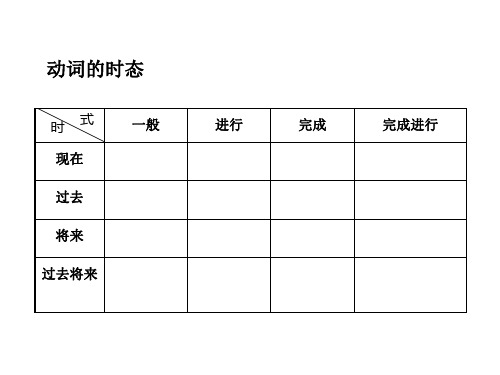
“意愿”,但不表示时态。
If you will accept my invitation and come to our party, my family will be pleased.如果你愿意接受并 参加我们的舞会,我的家人会非常高兴。
6)祈使句中 ( to give directions or instructions ) Go down the street, and then take the second turning on
the left.
知识扩展:一般现在时表将来
1)下列动词:come, go, arrive, leave, start, begin, return的一般 现在时表将来。这主要用来表示在时间上已确定或安排好的 事情 ( timetabled or fixed events )。 The train leaves at six tomorrow morning. When does the bus start? It starts in ten minutes.
You are always changing your mind. You are always doing well
He’s always asking the same question. 6. 状态动词的进行时后面接形容词brave; careful; stupid; clever; foolish; polite; kind; shy等时,为 主语所表现的非一般惯性特点或故意的行为。
6 )在the more…the more…句型中,从句也要用一 般现在时取代将来时。
英语时态ppt课件

I was told that she was leaving for New York the next day. = I was told she would leave for New York the next day.
3. 一般将来时 (in future / in the future / from now on / soon / in 5 years / next year / in the 22nd century…)
构成法: will/shall + 动词原形
In future, we’ll pay more attention to the protection of our environment.
3. 有部分动词(主要是短暂性动作动词)可以用进行时代替 将来时,即:用现在进行时代替一般将来时,用过去进行时 代替过去将来时. (也可用将来时)
Are you doing anything special this evening ? =Are you going to do anything special this evening?
Yesterday afternoon, he was painting me a picture. Now I ‘m going to see whether he has finished it. (强调paint这一动作过去在进行,但未交代是否已做完)
-----Why didn’t you answer my phone call last night ?
构成法: had + 动词过去分词
小学英语时态-PPT

一般现在时
(2) 当句子中即没有be动词,也没有情态动词时 ①陈述句:We get up at 7:00 every morning. 疑问句→Do you get up at 7:00 every morning? 否定句→We don’t get up at 7:00 every morning. ②陈述句:She has a little brother. 疑问句→ Does she have a little brother? 否定句→ She doesn’t have a little brother.
现在进行时
1. The boy is playing basketball. 否定句:____________________________ 一般疑问句:_________________________ 肯定回答:__________________________ 否定回答:__________________________
12. We _________ (not watch) TV on Monday.
13. Nick_______ (not go) to the zoo on Sunday.
14. They _________ (like) the World Cup?
按要求完成句子
1.Do you often play football after school? (肯 定回答) 2. I have many books. (改为否定句) 3. Gao Shan’s sister likes playing table tennis (改为否定句) 4. She lives in a small town near New York. (改为一般疑问句) 5. I watch TV every day. (改为一般疑问句) 6. David has got a goal. (改为一般疑问句)
英语时态总结表格

lied - 撒谎lie-lied-lied-lying 小方法:说谎很简单
He has lied since his childhood. 他从小就一直撒谎.
I’m sorry I lied to you. 我很抱歉向你撒了谎
She lies about her career. 她编造她的经历.
规则的说谎 lie-lied-lied, 不规则的躺 lie-lay-lain, 躺过就下蛋 lay, 下蛋不规则 lay-laid-laid
规则的说谎lie-lied-lied, 不规则的躺lie-lay-lain, 躺过就下蛋lay, 下蛋不规则lay-laid-laid
巧记: 规则撒谎意思是:撒谎是不道德的,所以我们要给它制定
13.He was sure that he _C___ his wallet in the office .
A. left B. would leave C. had left D. has left
lie lay 区别
意思
过去式 过去分 现在分
词
词
lie
躺;位于;lay
lain
lying
在 vi
9.He told me that he _D___ to see us the next day.
A . comes B. came C. will come D. would come
10.The teacher told us that the sun __A____ bigger
than the earth. A. is B. was C. has been D . will be
worked.shall仅用于主语是第一人称时,will可 用于主语是任何人称时.当然,根据shall / will 的 用法要求,紧随其后的动词或助动词要用原形形 式.
一般现在时现在进行时和一般过去时和一般将来时态ppt(共26张PPT)

• Were you born in 1980?
第二种 含有行为动词的
• 肯定结构
• 主语+行为动词(过去式)+其它 否定结构
主语+didn’t+行为动词(原形)+其
它 一般疑问句结构
Did+主语+行为动词(原形)+其它?
看来将要发生的事或存在的状态。
• 肯定句:主语+ will+动词原形------
• There will be a computer on every desk in the future.
• 未来每个桌子上都将有一台电脑。 • It will rain tomorrow. 明天将要下雨。 • We will go to school on foot.
• 我们将步行去上学。
• 特殊疑问句:疑问词+一般疑问句?
• 一般将来时II: is/am /are going to + 动词原形的
用法。
• 1、主要用来表示打算或计划要做某事, 主语是人。
如: • She is going to learn Japanese next year. • There is going to be a football match tonight. • Dad and I are going to see Beijing opera this
未来每个桌子上都将有一台电脑。 今天下午我和爸爸打算去看京剧。
swim
chat
第二种 含有行为动词的
I am going to go swimming tomorrow(明天).
2.主语为非第三人称单数的情况
英语八大时态PPT课件(详细版)

A
知识导航
种类
一般现在时 一般过去时 一般将来时 现在进行时 现在完成时 过去进行时 过去完成时 过去将来时
构成
do/does did will/shall+动词原形 am/is/are + doing have/has+过去分词 was/were + doing had+过去分词 would/should+动词原 形
A
4
※表示主语所具有的特征、性格、 能力、状态等
She is a middle school student. She looks a little worried. ※某些以here/there开头的句子 中,用一般现在时表正发生的动 作
Here comes the bus.
A
5
※表示将来发生的、时刻表上不改变的事 The train leaves Hunan at five o’clock. ※特殊情况 在时间状语从句和条件状语从句中,若主 句用一般将来时,则从句用一般现在代替 将来。(主将从现)
A
21
四、一般将来时
1、构成 一般将来时态由
“will/shall+动词原形”构成,me to ask Mary for help.
A
22
2、其他表示
※be going to +动词原形:表示 说话人主观的打算或预测。 I am going to look for a job here. It is going to be a fine day for camping tomorrow.
【小试牛刀】 他们昨天这个时候正在吃晚餐。
They were having dinner this time yesterday.
英语动词时态表_图文
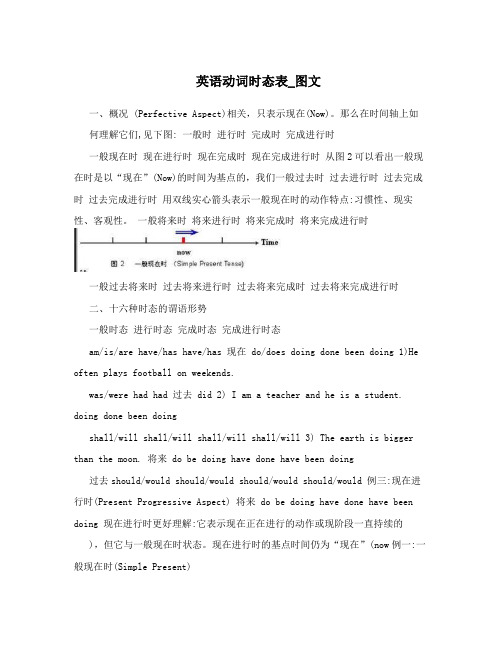
英语动词时态表_图文一、概况 (Perfective Aspect)相关,只表示现在(Now)。
那么在时间轴上如何理解它们,见下图: 一般时进行时完成时完成进行时一般现在时现在进行时现在完成时现在完成进行时从图2可以看出一般现在时是以“现在”(Now)的时间为基点的,我们一般过去时过去进行时过去完成时过去完成进行时用双线实心箭头表示一般现在时的动作特点:习惯性、现实性、客观性。
一般将来时将来进行时将来完成时将来完成进行时一般过去将来时过去将来进行时过去将来完成时过去将来完成进行时二、十六种时态的谓语形势一般时态进行时态完成时态完成进行时态am/is/are have/has have/has 现在 do/does doing done been doing 1)He often plays football on weekends.was/were had had 过去 did 2) I am a teacher and he is a student. doing done been doingshall/will shall/will shall/will shall/will 3) The earth is bigger than the moon. 将来 do be doing have done have been doing 过去should/would should/would should/would should/would 例三:现在进行时(Present Progressive Aspect) 将来 do be doing have done have been doing 现在进行时更好理解:它表示现在正在进行的动作或现阶段一直持续的),但它与一般现在时状态。
现在进行时的基点时间仍为“现在”(now例一:一般现在时(Simple Present)的动作不同:它的动作特点是进行性或持续性,我们用稍长的单实线表示我们知道,一般现在时有以下几种常见的用法:1)表示现在经常性的动作;2)表示现在的情况或状态;3)表示不受时限的客观事实或真理(实际上这些客观真理或事实都是人们以“现在”(Now)的观点或标准来做出评判的,它们仍然是人们在“现在”这个时间段里所理解、所认识的客观世界)。
英语十六时态表格总结
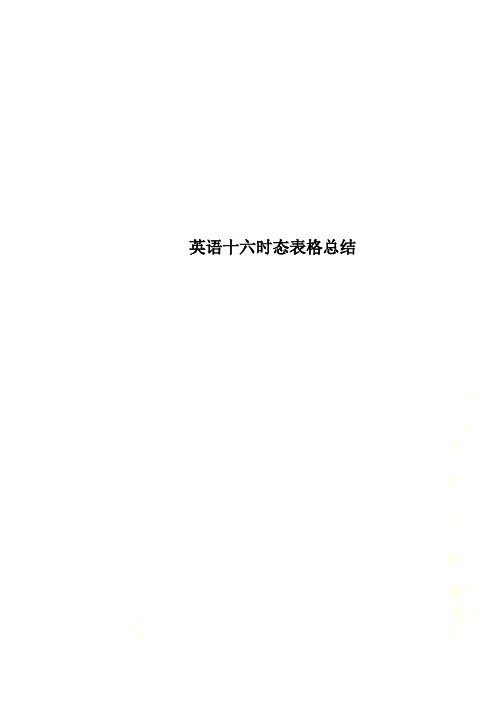
英语十六时态表格总结定义时间状语结构一般疑问句否定句形式1、一般现在时经常、反复发生的动作或行为及现在的某种状况。
often,usually,always,sometimes,everyday(week,month),once a week,on Mondays,etc.1.be动词2.行为动词主语+be+其他1.把动词be放于句首。
2.用助动词do提问,如主语为第三人称单数,则用does,同时还原为动词原形。
1.am/is/are+not2.此时态的谓语动词若为行为动词,则在其前加don’t;若主语为第三人称单数,则用doesn’t,同时还原行为动词。
2、现在进行时表示现阶段或说话时正在进行的动作或状态。
now, at thistime, thesedays, etc.主语+am/is/are+doing把be动词放在句首。
主语+am/is/ are+not+doing3、过去某个时间ago,yesterday,1.was/w1.把was或were放于句首。
2.用助动词did提问,同时还原1.主语+was/were一般过去时里发生的动作或状态;过去习惯性、经常性的动作、行为。
lastweek(month,year…), in2000, justnow, one day,long longago, etc.ere2.行为动词过去式为动词原形。
+ not2. 在行为动词前加do在其前加didn’t,同时还原行为动词。
4、过去进行时表示过去某段时间或某一时刻正在发生或进行的动作或行为。
at this timeyesterday或以when引导的谓语动词是一般过去时的时间状语等。
主语+was/were+doing把was或were放在句首。
主语+was/were+not+doing5、现在完过去发生或已经完成的动作对现在already,yet, just,ever, never,before,recently,inhave/has+done把have或has放在句首。
英语时态讲解课件.ppt
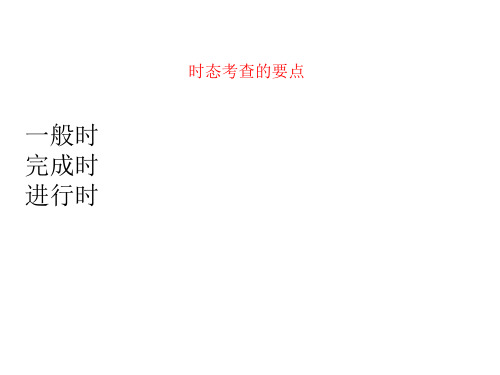
(2)现在完成时表示过去已经开始,持续到现在,也许还会持续下 去的动作或状态。可以和表示从过去某一时刻延续到现在(包括现 在在内)的一段时间的状语连用。 如:for和since,以及 so far, now, today, this week(month, year) 等。
① I haven’t seen her these days. ② She has learnt English for 3 years. ③ They have lived here since 1990. ④ What has happened to the USA in the last 350 years? 注意:表示短暂时间动作的词,如come, go, die, marry, buy等的完 成时不能与for, since等表示一段时间的短语连用。
-ing形式 going, looking
writing, taking
get, sit, put, run, getting, sitting,
begin
running,
beginning
现在完成时
1.现在完成时的构成:助动词have (has) + 动词的过去分词(done)
2.现在完成时的用法: (1)现在完成时表示过去发生或已经完成的某一动作对现在造成 的影响或结果。通常与表示包括现在在内的时间副词just,already, before, yet, never, ever ,up till now 等状语连用。 特别注意的是in the past/last+一段时间。 例如:
A. had met B. have met C. met
D. meet
答案B ;首先本题后句强调对现在的影响,我知道她的模样,你不 用描述。再次,several times告知为反复发生的动作,因此用现在 完成时。
英语时态汇总表 - 一般现在时上课课件
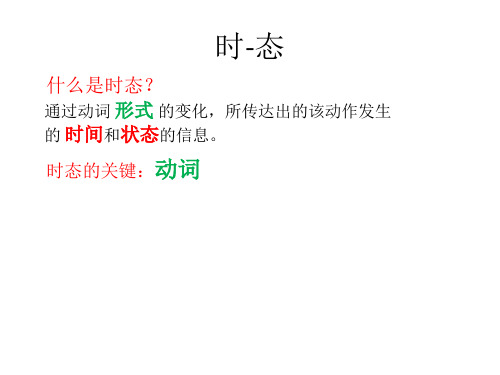
Pass→passes teach→teaches wash→washes
以辅音字母 + y 结尾 将 y 变为 i,再加-es
carry→carries study→studies
不规则变化
have→has be→am/is/are
1)表示经常性、习惯性的动作;表示现在的状态、特征和真理. 句中常用 often,usually,every day等时间状语。例如: He goes to school every day.(经常性动作) He is very happy.(现在的状态) The earth moves around the sun.(真理)
时-态
什么是时态? 通过动词 形式 的变化,所传达出的该动作发生 的 时间和状态的信息。
时态的关键:动词
十六种时态
时态
一般
进行
完成
完成进行时
现在
一般现在时
现在进行时 现在完成时 现在完成进行时
过去
一般过去时
过去进行时
过去完成时 过去完成进行时
将来
一般将来时
将来进行时
将来完成时 将来完成进行时
过去将来 一般过去将来时
1.一般现在时
一般现在时
定义 结构 时间标志词 句型转换 特殊考点/易错点
1.一般现在时的定义
1)表示经常性、习惯性的动作;表示现在的状态、特征和真理. 句中常用 often,usually,every day等时间状语。例如: He goes to school every day.(经常性动作) He is very happy.(现在的状态) The earth moves around the sun.(真理)
英语时态ppt
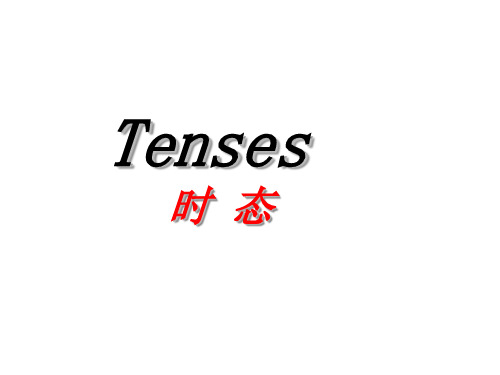
某些固定句式中的动词时态
1)This/ It is the first/second…time + that 从句。从句 一3般) b用e现(w在a完s/ 成we时re,) 如do果in把g…前w面h的enis…改.;为was, 则24)t)hIbHtaeiatsr(从/dwhla句ayssh用/bawe过dee…去nred+)完oa一n成beo段时…u时t。wt间hoe+dnso…i…n;cweh从e句n…。;Since从句中 Th一is般hNiaos用dtsh过doeoo去nfnier时es…rt。hwtaimhde…enI…dhoanvee…cothmaen…he意re为. “一…..就……” ItIHTHrtwaehiaasienrhsdtyawpltsywhooebu(eNyerrteeehoeadinrrsreddsoianootsdiwtnmiihnneneecgr.e)a(wthrhhmhaeadeytjn)o/IhaiTgneoosemthodhaldtsdohihmeemoreauafrotdwmerehdyttew.ihnnoe(pytsaheaiaamnnr.es) .tmheistake.
时态的替代
1. no matter加疑问词以及疑问词与ever构成的合成词引 出的从句中,要用一般现在时代替一般将来时. Wherever you go, you will get a warm welcome.
2. 有部分动词(主要是短暂性动作动词)可以用进行时代替 将来时,即:用现在进行时代替一般将来时,用过去进行时 代替过去将来时. (也可用将来时)
高中英语16种英语时态讲解(共43张PPT)
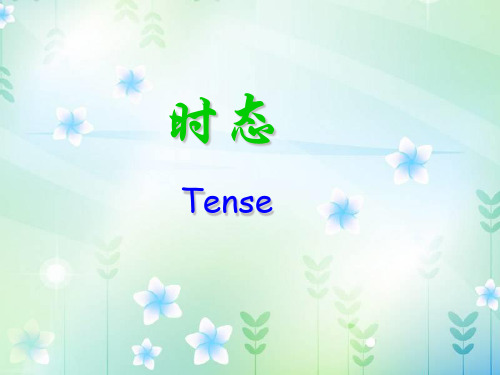
• Someone is knocking at the door. I’ll go and open it.
8
五、现在进行时态
现在进行时的基本用法
形式: am/is/are + doing
现在进行时的基本用法
用法3: 表示最近的将来一定的安排. 通常含有“计划”, “安排做”之意.
• I am taking a makeup test tomorrow. • — what are you doing on Saturday night?
— I’m doing some shopping with Jane. 用法4: 常与always, forever, continually, constantly 等连用,表示抱怨,厌烦, 不合情理或使人不愉快的事.
一般现在时的基本用法
形式:
do 或does(第三人 称单数)
用法1: 表示经常发生的习惯性的动作或者存在的状态.
• He often goes to the gym.
• I like the rice for dinner.
• He doesn’t work hand.
此用法常与一些表示动作频率的时间副词连用(副词放在be动词之 后, 实义动词之前).
3
二、一般现在时态
一般现在时的基本用法
用法2: 表示不受时间限制的事实陈述或客观性的真理. • The earth moves around the sun. • The sun rises in the east and sets in the west. • Knowledge is power.
- 1、下载文档前请自行甄别文档内容的完整性,平台不提供额外的编辑、内容补充、找答案等附加服务。
- 2、"仅部分预览"的文档,不可在线预览部分如存在完整性等问题,可反馈申请退款(可完整预览的文档不适用该条件!)。
- 3、如文档侵犯您的权益,请联系客服反馈,我们会尽快为您处理(人工客服工作时间:9:00-18:30)。
on the playground. ( play ) A. plays B. play C. have played D. are playing
3.He said that he __w_o_u_ld_c_o_m__e back in five minutes . ( come ) 4.He_w_a_s__li_s_te_n_in_g_to the radio when I came in, ( listen ) 5.Look at the cloud .I think it_w_i_ll_r_a_in. ( rain ) 6. I need some paper . I__w_i_ll_b_ri_n_g_ some for you . ( bring )
化而变化。) 现在完成时: have + worked (have随主语人称和数
的变化而变化,worked是work的过去分词。) 这三种基本时态形式位于时态表的中心位置,是必须
首先记住的。其它形式可推导而出。
过去时
记住了上面三种时态的形式后,可以设 想把时间提前至过去,这三种时态的形 式就相应地左移一格成为
had been doing
has/have
行时
been doing will/shall have would/should
been doing have been doing
英语十二种时态 (十六)
时间 时态
过去
现在
将来
过去将来
一般 进行
一般过去时 一般现在时 一般将来时 一般过去将来时
动词原形 do/does
___A___ fine tomorrow. A. is B. was C. will be D . is going to be
9.He told me that he _D___ to see us the next day.
A . comes B. came C. will come D. would come
would/should be doing
完成
过去完成时 现在完成时 将来完成时 过去将来完成时
had done
has/have done
will/shall would/should have done have done
完成进行 过去完成进行时 现在完成进行时 将来完成进行时 过去将来完成进
had been doing
过去进行时 现在进行时 将来进行时 过去将来进行时
am/is/are doing
完成
过去完成时 现在完成时 将来完成时 过去将来完成时
has/have done
完成进行
过去完成进行时 现在完成进行时 将来完成进行时 has/have
过去将来完成进 行时
been doing
英语十二种时态 (十六)
时间 时态
7.By the end of last year he __D____ about 1500 English words.
A. learns B . learned C . was learning D . had learned 8..We’ll go swimming if the weather
英语十二种时态 (十六)
时间 时态
过去
现在
将来
过去将来
一般 进行
一般过去时 一般现在时
动词过去式 did
动词原形 do/does
过去进行时 现在进行时
was/were doing
am/is/are doing
一般将来时 一般过去将来时
will/shall would/should
do
do
将来进行时 过去将来进行时
(shall仅用于主语是第一人称时,will可用于 主语是任何人称时。)当然,根据shall / will 的用法要求,紧随其后的动词或助动词要用原 形形式。
1.He __B__(gvery day in summer. A. go B. goes C. went D. has gone
英语十二种时态 (十六)
时间 时态
过去
现在
将来
过去将来
一般
一般过去 一般现在 一般将来 一般过去将
时
时
时
来时
进行
过去进 现在进 将来进
行时
行时
行时
过去将来 进行时
完成
过去完 现在完 将来完
成时
成时
成时
过去将来 完成时
完成进行 过去完成 现在完成 将来完成 过去将来完 进行时 进行时 进行时 成进行时
一般过去时: worked (worked是work的 过去式);
过去进行时: was / were + working; 过去完成时: had + worked (worked是
work的过去分词)。
将来时
把时间错后至将来,这三种时态的形式也就相 应地右移一格成为
一般将来时: shall / will + work; 将来进行时: shall / will + be working; 将来完成时: shall / will + have worked。
will/shall be doing
would/should be doing
完成
过去完成时 现在完成时 将来完成时 过去将来完成时
had done
has/have done
will/shall would/should have done have done
完成进行 过去完成进行时 现在完成进行时 将来完成进行时 过去将来完成进
过去
现在
将来
过去将来
一般 进行
一般过去时 一般现在时
动词过去式 did
动词原形 do/does
过去进行时 现在进行时
was/were doing
am/is/are doing
一般将来时 一般过去将来时
will/shall would/should
do
do
将来进行时 过去将来进行时
will/shall be doing
has/have
行时
been doing will/shall have would/should
been doing have been doing
现在时
记忆法(常用时态): 一般现在时: work/works(当主语是第三人称单数时,
谓语动词也要用第三人称单数形式。) 现在进行时: be + working (be随主语人称和数的变
